Our Team
Our small team consists of two industrial engineering students, Kyle and Vanessa.

Kyle Smith
Student Researcher
Kyle is a fifth year industrial engineering undergraduate student at California Polytechnic State University, San Luis Obispo. His interests include operations research and video games.

Vanessa Veto
Student Researcher
Vanessa Veto is an industrial engineering student at California Polytechnic State University, San Luis Obispo. She enjoyed combining her experiences playing and coaching youth sports with her interest in operations research.
Acknowledgements
Thank you to our project mentor Dr. Cheng for the continued guidance and support in our research.
We would also like to thank Arroyo Grande AYSO and San Luis Obispo YMCA.
Special thanks to Coach Amy Howes of AYSO SLO Youth Basketball team.
Our Project Video
Our Project's Digital Poster
Abstract
Conflicts regarding playing time allocation in youth sports are a recurring problem. The body of literature regarding youth sports indicates that a lack of playing time may contribute to lower rates of participation. Although some tools exist to help coaches provide equal playing time for their players, they do not create an optimized substitution schedule for an entire season. Our team addressed this problem by using binary goal programming to create substitution schedules for youth basketball and soccer that balanced equal playing time with performance goals.
Introduction
Playing time allotment in youth sports is a difficult task for coaches. Disputes regarding playing time detract from the players’ sports experience. Guaranteeing that each player in youth team sports plays for an equal amount of time builds camaraderie and is an inclusive practice. Most current scheduling models outline a substitution pattern for only a single game. Following this schedule for an entire season is repetitive and less engaging for players. Furthermore, current equal playing time solutions do not consider the team’s competitive performance. Therefore, a more comprehensive solution is necessary.
Methodology
Overview
Our team used binary goal programming to create substitution schedules for youth basketball and soccer that balanced equal playing time with performance goals. These models minimized the deviation from the calculated average playing time for each player per game across the season. The model was also extended to minimize the deviation from the highest team performance measurement per game for the entire season. Additional constraints were met such as rotating all players through the starting lineup and ensuring a player does not stay out of the game for more than two quarters at a time. Sport-specific performance factors were also considered. Our proposed models generated optimal solutions for various combinations of team sizes and season durations.
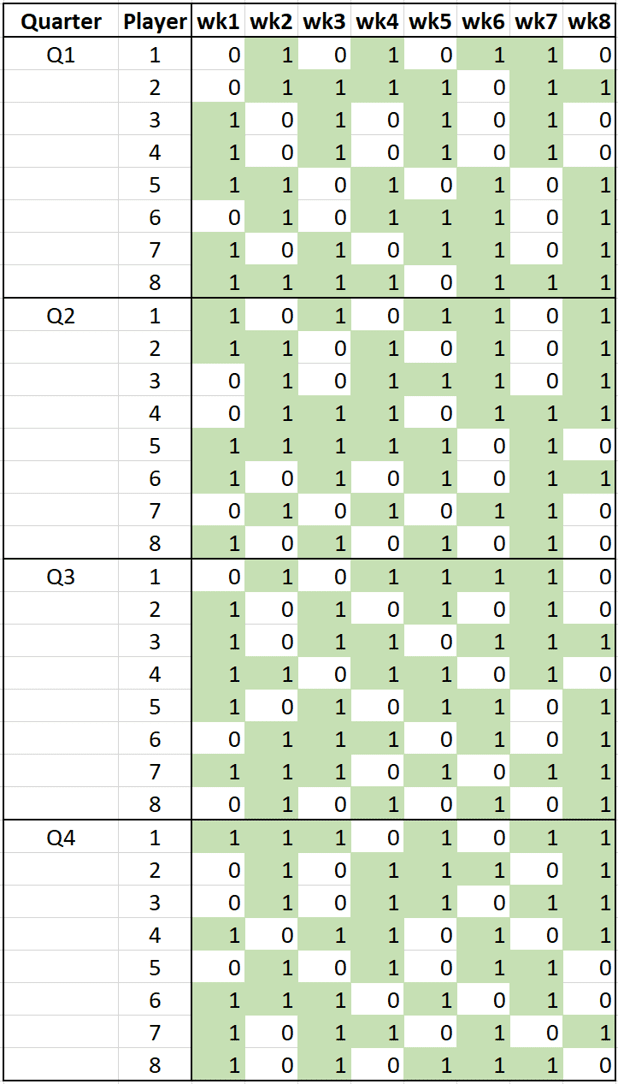
Sample substitution pattern for eight players over eight games. “1” indicates that a player is assigned to a specific time slot.
Binary Goal Programming Model

Parameters describing the team size, season duration, and required number of players that must be in the game at a time

Indices defining the team size, season duration, and quarters in a game

The assignment variable and the deviational variables

The objective function
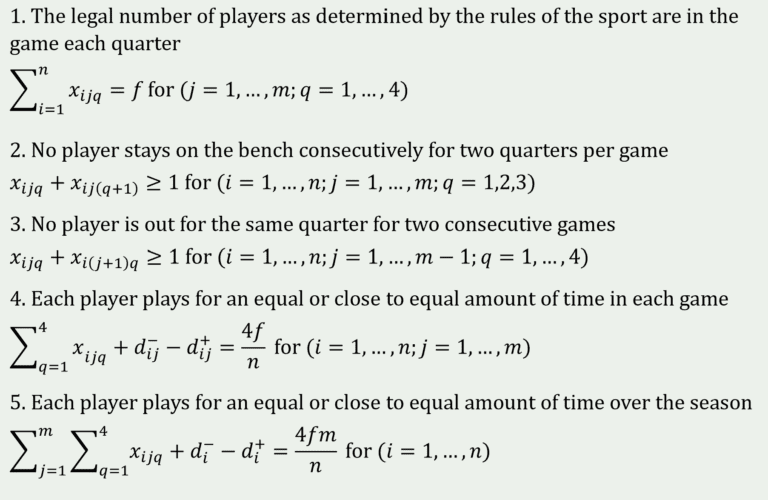
The model’s constraints
Extensions
- Performance: The soccer model was extended to consider competitive team performance. The coach assigns a skill rating to each player and the model seeks to maximize the sum of the skill ratings of players on the field.
- Positions: The soccer model was enhanced to account for equal playing time in each position. The model assigns players to different positions with a new binary variable in a separate set of tables.
- Key Players: If a coach wants to keep particular players on the court, the model can ensure that a specified number of these players are on the court at any given time.
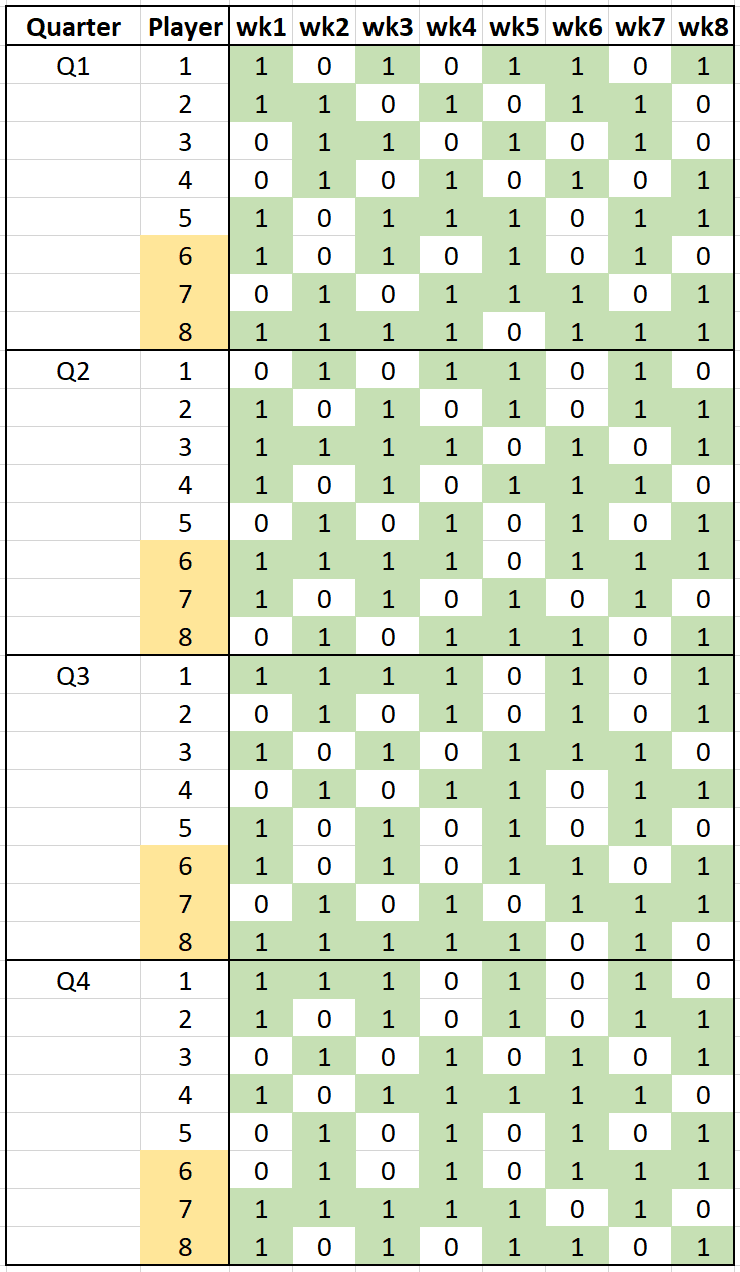
Sample substitution pattern for eight players and eight games including three key players (6, 7, 8) of which two must be on the field/court each quarter.
Results
Compared to existing substitution patterns, our goal programming model provided more weekly variation. Furthermore, in a simulation analysis of uncertain player attendance, our model had superior performance in terms of deviation from seasonal average playing time.
We investigated teams of various sizes to find the optimal number of players for a roster. Additionally, sensitivity analysis was done to determine the effects of changing the weight of performance and equal playing goals. Increasing performance weight decreased the deviation from the maximum performance score. It also increased the deviation from equal playing time.
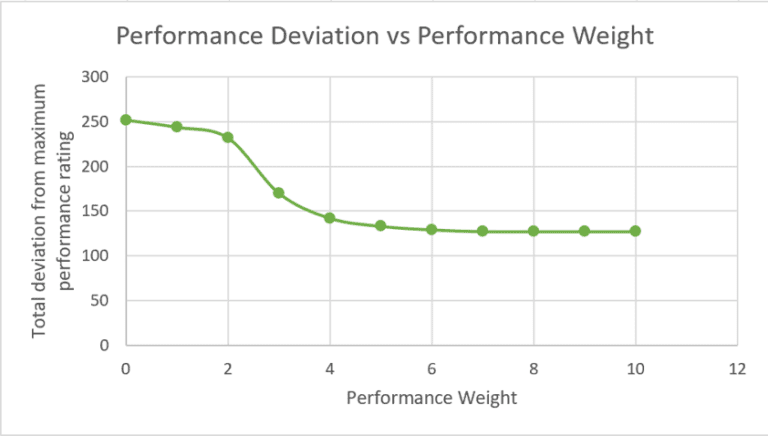
Sensitivity analysis showing the effect of performance weight on performance deviation
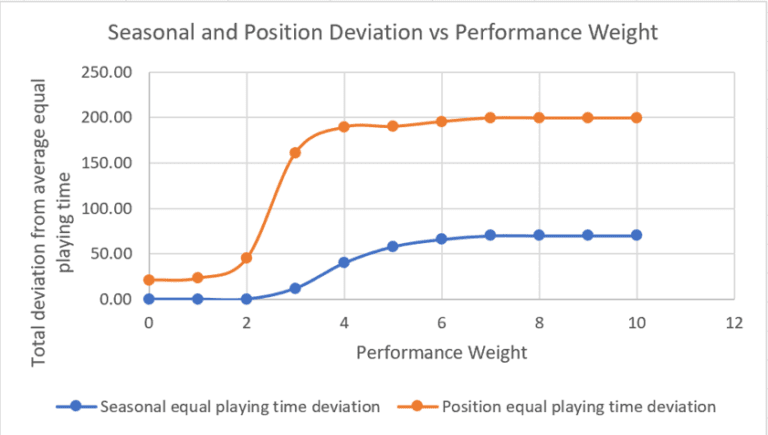
Sensitivity analysis illustrating the effect of performance weight on equal playing time
Conclusion and Future Directions
Overall, the results our research indicate that goal programming is a viable option for modeling substitution scheduling in youth basketball and soccer. The resultant substitution patterns were posted on our website for youth sports coaches to use for their teams. Implementing optimization models would make equal playing time more accessible for youth sports teams and benefit parents, coaches, and players.
Directions for future research include developing models suited for other youth sports. This would enable many more coaches to implement equal playing time for their players, thereby enhancing their youth sports experience.

